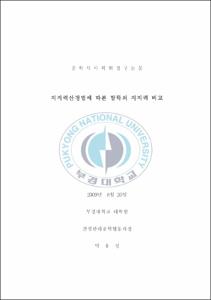지지력산정법에 따른 말뚝의 지지력 비교
- Alternative Title
- Comparison and Evaluation of Pile Bearing Capacity by Estimating Method
- Abstract
- 지지력산정방법중 말뚝정재하시험은 지지력을 산정 방법중 신뢰성이 높은 장점이 있음에도 불구하고 경제적인 문제로 실제시행에 있어서는 제한적으로 될 수 밖에 없다, 특히 정재하시험에 의해 주면 지지력을 구하기 위해서는 말뚝하중전이시험을 수행해야하며 이는 특히 경제적인 문제뿐만 아니라 기술적인 문제 및 시간상 수행하기 대단히 어렵다. 따라서 본 연구에서는 동일한 말뚝에 대하여 하중전이시험을 포함한 정재하시험 및 동재하시험과 정력학적방법에 의한 말뚝지지력을 상호간 비교 고찰하여 그 특성을 파악하고 결론을 도출하였다.
Although pile load test is the most reliable methods among method of estimating pile bearing capacity, it is pretty difficult to use that method because of economical problems. Especially, load transition test which is one type of pile load test contains technical problems, as well as economical problems.
This study's purpose is to compare and evaluate bearing capacity estimated by load transition test(pile load test), dynamic method and static method. This study uses data of A, B and C sites.
Results of comparing and evaluating data are as follow:
1. Ratios of point resistance by static method and dynamic method are relatively bigger than ratio of point resistance by load transition test.
2. In general, that axial force estimated by load transition test decrease with depth. But if pile diameter locally enlarges or narrows, axial force isn't distributed at changed section.
3. Ratios of skin friction resistance by static method and dynamic method are smaller than ratio of skin friction resistance by load tansition test. That means skin friction resistance has been generally underestimated.
4. Proportions of point resistance against total resistance by static method, load transition test and dynamic method are respectively 57% ~ 64%, 9%~49%, 18%~70%, approximately.
5. Proportions of skin friction resistance against total resistance by static method, load transition test and dynamic method are respectively 36% ~ 42%, 51%~91%, 30%~81%, approximately.
In conclusion, result of comparing design load with load estimated by load test shows that safety factor has been overestimated. However, sample data of this study is not enough, so result of this study maybe inappropriate to be applied to real construction site. There is a need to further examine and validate the result of this study.
- Issued Date
- 2009
- Awarded Date
- 2009. 8
- Type
- Dissertation
- Publisher
- 부경대학교 대학원
- Alternative Author(s)
- Park, Yong-Jung
- Affiliation
- 부경대학교 대학원
- Department
- 대학원 건설관리공학협동과정
- Advisor
- 김수용
- Table Of Contents
- 1. 서론 = 1
1.1 연구배경 및 목적 = 1
1.2 연구의 목적 = 2
1.3 연구 범위 = 3
1.4 연구방법 = 3
2. 문헌연구 및 이론적 고찰 = 5
2.1 연구동향 = 5
2.2 지지력 산정이론 = 11
2.2.1 정역학적 방법 = 11
2.2.2 동역학적 방법 = 12
2.2.3 정재하시험(하중전이시험) 방법 = 13
2.2.4 동재하시험 = 23
3. 자료수집 및 정리 = 28
3.1 말뚝재하시험 자료수집 = 28
3.1.1 A 현장 = 28
3.1.2 B 현장 = 33
3.1.3 C 현장 = 41
4. 결과 및 고찰 = 47
4.1 결과 = 47
4.1.1 A현장 말뚝 지지력 결과 = 47
4.1.2 B현장 말뚝 지지력 결과 = 59
4.1.3 C현장 말뚝 지지력 결과 = 76
4.2 고찰 = 91
4.2.1 선단지지력에 대한 고찰 = 96
4.2.2 주면마찰력에 대한 고찰 = 96
4.2.3 지지력 산정방법에 따른 경제성 고찰 = 97
5. 결론 = 99
참고문헌 = 101
- Degree
- Master
- Appears in Collections:
- 대학원 > 건설관리공학협동과정
- Files in This Item:
-
-
Download
 지지력산정법에 따른 말뚝의 지지력 비교.pdf
기타 데이터 / 8.5 MB / Adobe PDF
지지력산정법에 따른 말뚝의 지지력 비교.pdf
기타 데이터 / 8.5 MB / Adobe PDF
-
Items in Repository are protected by copyright, with all rights reserved, unless otherwise indicated.